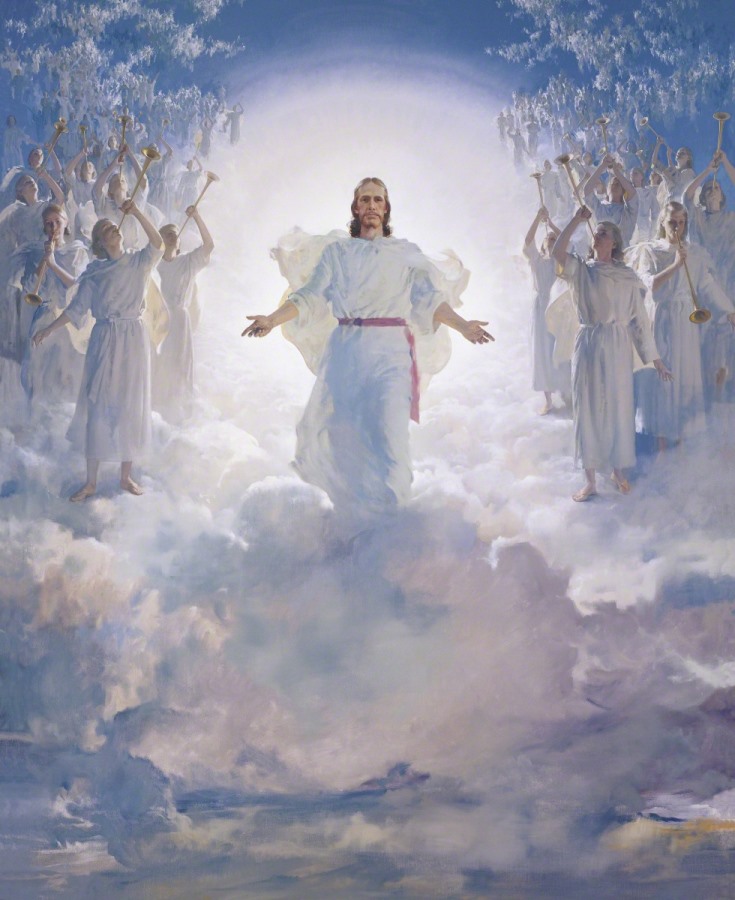If we want evidence that Hebrew Feast Days are truly “appointments” for holy occasions, let’s see if they align with any past and then future events. Here are only some:
(1) Events of the last week of Christ’s mortal life,
(2) God and Moses parting the Red Sea,
(3) God and Joshua parting the Jordan River,
(4) The fall of the walls of Jericho,
(5) Feasts Days aligned with events of the Restoration of the Gospel in our day through the Prophet Joseph Smith,
(6) Christ coming at Adam-ondi-Ahman to the faithful,
(7) Christ splitting the Mount of Olives to rescue the Jews at the end of Armageddon,
(9) The “Hidden Day” or Day 8 of Tabernacles symbolizing Christ’s Final Coming in the Clouds – The Day and the Hour No Man Knoweth (Matthew 24:36)
LET’S LOOK AT THE DETAILS:
(1) THE LAST WEEK OF CHRIST’S LIFE line up perfectly with PASSOVER EVENTS:
Nisan 10 (Monday): Triumphal entry of Christ into Jerusalem on the day the Shepherds annually brought the Temple Lambs to be inspected and selected by the priests. He was the real Lamb, and ever after called The Lamb of God. See John 12:1-19)
Nisan 14 (Friday): Passover which starts at sundown and followed by: the Last Super, Gethsemane, betrayal by Judas, scourging, trials, crucifixion, burial just before sundown, and the end of that day, when “the Sabbath” would begin.
Nisan 15 (Saturday): First Day of Unleavened Bread and a High Holy “Sabbath”
Nisan 16 (Sunday): Weekly Sabbath – Originally held on Sunday, only later changed by Hillell II to Saturday in response to Constantine’s actions (SOURCE). The two Sabbaths fulfill the “3 days and 3 nights in the tomb,” see Jonah 1:17, Matthew 12:40.
Nisan 17 (Monday): FirstFruits when Christ is resurrected early in the morning. See Mark 16:9; Matthew 28:1; John 20:1, 14-16.
This is the exact sequence of celebration that had been followed by the Israelites for 1500 years, since the Exodus with Moses at Mt Sinai, in preparation for these events. The Israelites were so blinded by tradition and the pride of their leaders, few recognized the lowly man from Nazareth as their awaited Messiah. The tribe of Judah and their descendants paid a fearsome price for the His crucifixion, which will only to reach final resolution when Christ comes to rescue and forgive them at the Mount of Olives (Zechariah 14).
(2) GOD, WITH MOSES, PARTED THE RED SEA on the 7th day of Unleavened Bread, always on Nisan 21, which was also First Fruits that year, the original “Day of Deliverance for Israel”:
As far as the sequence of events, Passover was after sunset on the 14th of Nisan/Abib (Exodus 12:6) and the death angel passed-over at midnight (Exodus 12:23-29). During the early daylight hours on the 14th of Nisan/Abib, the children of Israel received gold and precious things from the Egyptians (Exodus 12:35-36). They left Egypt at night of the 15th of Nisan/Abib (Exodus 12:42; Deuteronomy 16:1). Late on the 16th of Nisan/Abib, the children of Israel arrived in Succoth (Exodus 12:37). Later, apparently on the 18th of Nisan/Abib, Pharaoh decided to pursue them (Exodus 14:5). On the 20th of Nisan/Abib, Pharaoh’s armies get near the children of Israel (Exodus 14:9). On the 21st of Nisan/Abib, GOD PARTED THE RED SEA AND THE CHILDREN OF ISRAEL CROSSED IT ON DRY LAND (Exodus 14:20-22, 29). [Then] during the daylight hours of the 21st, the Egyptian army pursues and is destroyed (Exodus 14:23-28).
NOTE: The Israelites cross the Red Sea on a Day of Deliverance: Nisan 21 when FirstFruits coincides with the 7th day of Unleavened Bread. See earlier POST for explanation, and remember days in the Hebrew calendar go from sundown to sundown, not midnight to midnight.
Source: https://www.cogwriter.com/news/doctrine/7th-day-of-unleavened-bread/
(3) GOD, WITH JOSHUA, PARTS THE JORDAN RIVER for the Israelites to finally enter the Promised Land, arguably on Yom Kippur or the Day of Atonement, the most holy day in the Jewish calendar: And the people came up out of Jordan on the TENTH DAY OF THE FIRST MONTH, and encamped in Gilgal, in the east border of Jericho (Joshua 4:19). We know that Nisan in the spring is the “first month” in the Jewish calendar, but there are 2 Jewish New Years annually: Nisan 1 (the Passover feasts) and Tishri 1 six months later (the feasts surrounding the Day of Atonement). Which is the “first month” referred to above? See Joshua 5:8-9: Shortly after crossing the Jordan: 8 And it came to pass, when they had done circumcising all the people, that they abode in their places in the camp, till they were whole. 9 And the Lord said unto Joshua, This day have I ROLLED AWAY THE REPROACH OF EGYPT from off you. Yom Kippur or Day of Atonement on Tishri 10 is the one day of the year that the Lord forgives sins in Israel, which is then followed by 5 days of preparation and 7 days of the Feast of Tabernacles, the most joyous festival in the Jewish calendar that celebrates being forgiven and the prospect of dwelling with the Lord and His protection and care. So I maintain this is when the 40 years of wandering and condemnation were lifted off the Israelites, because it better matches the wording and significance of this event.
(4) THE WALLS OF JERICHO FELL on day 7 of Unleavened Bread that also coincided with FirstFruits. These two will foreshadow when Christ comes to Adam-ondi-Ahman on FirstFruits, which also occurs when it is also the 7th day of Unleavened Bread. Evidence here:
Joshua 3:7 This day will I begin to magnify thee in the sight of all Israel, that they may know that, as I was with Moses, so I will be with thee.
Joshua 5:10 And the children of Israel encamped in Gilgal, and KEPT THE PASSOVER on the fourteenth day of the month at even in the plains of Jericho. (NISAN 14)
NOTE: Then continuing immediately after Passover:
Joshua 6:1-5:
1 Now Jericho was straitly shut up because of the children of Israel: none went out, and none came in.
2 And the Lord said unto Joshua, See, I have given into thine hand Jericho, and the king thereof, and the mighty men of valour.
3 And ye shall compass the city, all ye men of war, and go round about the city once. Thus shalt thou do SIX DAYS.
4 And seven priests shall bear before the ark seven trumpets of rams’ horns: and the SEVENTH DAY ye shall compass the city seven times, and the priests shall blow with the trumpets.
5 And it shall come to pass, that when they make a long blast with the ram’s horn, and when ye hear the sound of the trumpet, all the people shall shout with a great shout; and the wall of the city shall fall down flat, and the people shall ascend up every man straight before him.
NOTE: The SEVENTH DAY is of the Feast of Unleavened Bread and in this year was almost certainly also a day of FIRSTFRUITS and therefore a DAY OF DELIVERANCE.
(5) HEBREW FEASTS ALIGN WITH THE RESTORATION of the Church of Jesus Christ of Latter-day Saints. Here’s a sampling:
FEAST OF TRUMPETS when Joseph took plates out of the ground on September 22, 1827 – The Book of Mormon’s call was to REPENTANCE and to PREPARE, both physically and spiritually, for the great days ahead. This matches the ancient meaning of this important day (Tishri 1).
The Day Before PASSOVER – The Church is organized on April 6, 1830 (Nisan 13).
TRUMPETS – Mission calls are issued September 14, 1830 to take the Book of Mormon to the Lamanites in Missouri (Tishri 1).
PASSOVER – Priesthood Keys are restored in the Kirtland Temple, April 3, 1836 (Nisan 14).
SHABBAT NACHAMU (the Sabbath of Consolation, 1 of 7 each year) – The first settlers arrive in Salt Lake Valley, July 24, 1847.
(6) CHRIST COMES TO ADAM-ONDI-AHMAN, also another “Day of Deliverance for Israel” – when Michael stands up, and Christ appears. Details coming soon!
(7) CHRIST SPLITS THE MOUNT OF OLIVES on Yom Kippur or Day of Atonement when repentant Jews will finally be forgiven for His crucifixion, followed by the Feast of Tabernacles to which all Israel’s enemies are invited (see Zechariah 14).
(8) THE FINAL COMING IN THE CLOUDS on The “Hidden Day” of Tishri 22 – it will remain unknown until it actually happens because only Heavenly Father knows when every last person on Earth finally and definitely decides which church he chooses (Christ’s or the Devil’s), the last sifting of the “Sheep and Goats” before the Millennium.
See BLOG POST: The Day and the Hour No Man Knoweth for further explanation.

Courtesy The Church of Jesus Christ of Latter-day Saints
© 2023 Janet Kent – all rights reserved


